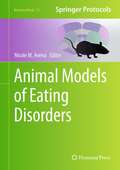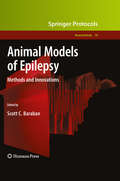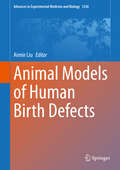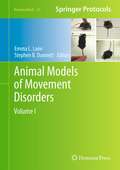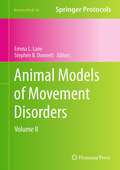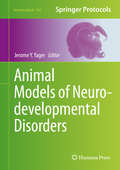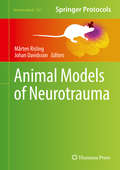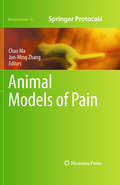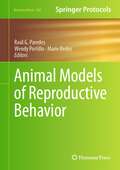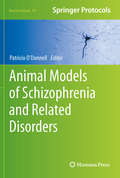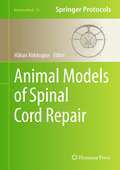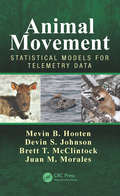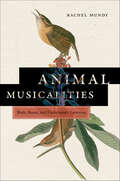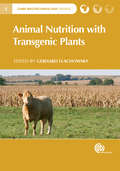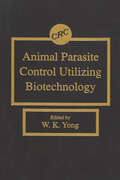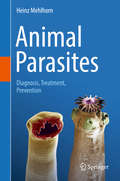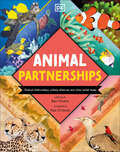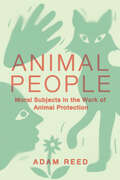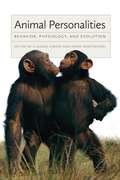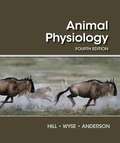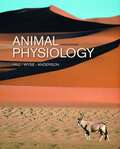- Table View
- List View
Animal Models of Eating Disorders (Neuromethods #74)
by Nicole M. AvenaThe growth of the field of eating disorder research has led to a vast array of empirical articles, and the development of new animal models that can be used to study these disorders continues to stimulate new research. Animal Models of Eating Disorders serves as a collection of detailed techniques contributed by experts in the field who are well-versed in the development and implementation of these models. Since eating disorders are complex and likely due to a combination of environmental, genetic, and social causes, the detailed chapters of this volume have been designed to highlight different contributing factors. Collectively, these chapters give a comprehensive and representative overview of both recently developed and classic methodologies used in the study of eating disorders. Written for the popular Neuromethods series, this work contains the kind of thorough description and implementation advice that promises successful results. Authoritative and practical, Animal Models of Eating Disorders aims to aid researchers in the use of animal models to assist in their investigation and characterization of the behaviors and neurochemical alterations associated with these devastating disorders.
Animal Models of Epilepsy: Methods and Innovations (Neuromethods #40)
by Scott C. BarabanWith its complex anatomical, molecular, electrophysiological and behavioral components, epilepsy provides the neuroscientist with nearly boundless opportunities to examine basic neurobiological mechanisms. In Animal Models of Epilepsy: Methods and Innovations, prominent investigators in the field examine several novel models of epilepsy in mice as well as in genetically tractable "simple" species such as Drosophila melanogaster (fruit flies), Caenorhabditis elegans (worms), Xenopus laevis (tadpoles) and Danio rerio (zebrafish). While covering some traditional models, the volume also explores the newest innovations like modeling seizure activity in silica and advanced strategies for seizure detection and gene therapy. As a volume in the successful NeuromethodsTM series, the chapters provide clear, step-by-step protocols and thought-provoking reviews of the most recent advancements in the field. Comprehensive and cutting-edge, Animal Models of Epilepsy: Methods and Innovations is an ideal guide for scientists who wish to expand our understanding of the pathogenesis of this neurological disorder.
Animal Models of Human Birth Defects (Advances in Experimental Medicine and Biology #1236)
by Aimin LiuThis book focuses on the use of animal models to study various human defects. It summarizes our current understanding of a variety of common human birth defects and the essential role of animal models in shedding light on the underlying mechanisms of these disorders. Birth defects are the leading cause of infant deaths, and cost billions of dollars in care for those affected. Unfortunately, the lack of a clear understanding of the mechanisms leading to many of these developmental disorders has hindered effective prevention and early intervention strategies. Studies using animal models have provided essential insights into several human birth defects. This book serves as a valuable reference resource for researchers and graduate students who are interested in learning the basic principles as well as the latest advances in the study of the mechanisms of human birth defects.
Animal Models of Movement Disorders, Volume I: Volume I (Neuromethods #61)
by Stephen B. Dunnett Emma L. LaneMovement is the way that animals interact with their environment and is under the organization and complex control of the brain and spinal cord. Multiple central nervous systems, including cortex, basal ganglia, cerebellum, and brainstem, interact to provide precise motor control and integration. Damage or disease within these systems cause profound motor disturbances in man, which can be effectively modeled in animals to develop a better understanding and treatment of the human condition. Animal Models of Movement Disorders introduces a variety of methods and techniques used to model and assess motor function in experimental animals from lower orders, such as drosophila and c. elegans, through vertebrate species including fish, to mammals, such as rodents and non-human primates. The most advanced contemporary models in each system are presented at multiple levels of analysis from molecular and genetic modeling, lesions, anatomy, neurochemistry, to imaging and behavior. Volume I contains general methods of movement disorder assessment as well as an extensive section on dopamine systems. <P><P> Comprehensive and meticulous, Animal Models of Movement Disorders serves as a valuable reference for those studying motor disorders by covering methodologies in detail and providing the information necessary to consider both the appropriate models and assessment tools that can most informatively answer the key experimental issues in the field.
Animal Models of Movement Disorders, Volume II: Volume II (Neuromethods #62)
by Stephen B. Dunnett Emma L. LaneMovement is the way that animals interact with their environment and is under the organization and complex control of the brain and spinal cord. Multiple central nervous systems, including cortex, basal ganglia, cerebellum, and brainstem, interact to provide precise motor control and integration. Damage or disease within these systems cause profound motor disturbances in man, which can be effectively modeled in animals to develop a better understanding and treatment of the human condition. Animal Models of Movement Disorders introduces a variety of methods and techniques used to model and assess motor function in experimental animals from lower orders, such as drosophila and c. elegans, through vertebrate species including fish, to mammals, such as rodents and non-human primates. The most advanced contemporary models in each system are presented at multiple levels of analysis from molecular and genetic modeling, lesions, anatomy, neurochemistry, to imaging and behavior. Volume II of this detailed collection contains sections on the basal ganglia, neo- and allo-cortical systems, cerebellar and brain stem systems, as well as spinal cord systems.<P><P> Comprehensive and meticulous, Animal Models of Movement Disorders serves as a valuable reference for those studying motor disorders by covering methodologies in detail and providing the information necessary to consider both the appropriate models and assessment tools that can most informatively answer the key experimental issues in the field.
Animal Models of Neurodevelopmental Disorders (Neuromethods #104)
by Jerome Y. YagerProviding a spectrum of models that is reflective of the various species that can be utilized in experimentation on disorders across a broad range of developmental disabilities, this volume collects expert contributions involved in investigation of the causes, outcomes, treatment, and prevention. Animal Models of Neurodevelopmental Disorders explores models of perinatal hypoxia-ischemia/cerebral palsy and stroke, autism spectrum disorder, fetal alcohol syndrome, as well as mental retardation. Written in the popular Neuromethods series style, chapters include the kind of detail and key advice from the specialists needed to get successful results in your own laboratory. Practical and authoritative, Animal Models of Neurodevelopmental Disorders serves to introduce and entice those interested in better understanding and treating these disorders to the vital animal model world of investigation.
Animal Models of Neurotrauma (Neuromethods #149)
by Mårten Risling Johan DavidssonThis volume looks into the need for a variety of experimental models for research on traumatic brain injury (TBI) and peripheral nervous system. It also describes a number of experimental models, such as mechanical devices, that have been developed to model neurotrauma in animal experiments. The overall aim of this book is to explore the variety of models and how they are used in current research. The chapters in this book are organized in four sections and talk about animal models for TBI; animal models for spinal cord or nerve injury; and translational aspects, secondary injuries, in vitro studies, and evaluation of large data sets. In Neuromethods series style, chapters include the kind of detail and key advice from the specialists needed to get successful results in your laboratory.Cutting-edge and comprehensive, Animal Models of Neurotrauma is a valuable resource for researchers interested in expanding their knowledge and research in this developing field.
Animal Models of Pain (Neuromethods #49)
by Jun-Ming Zhang Chao MaWith the loss of work days, the price of health care and payments for compensation, litigation, and malpractice, and the overwhelming cost of human suffering, chronic pain syndromes affect humanity enormously on both an economic and personal level. In Animal Models of Pain, expert investigators in the field provide a consolidated review of the current state of pain research by capturing the diversity of animal models that are used to investigate pain mechanisms, which range from surgical incision to mechanical compression and from spinal cord injury to cutaneous/local inflammation and beyond. As a volume in the respected Neuromethods series, this book delivers its vital content through detailed descriptions of a wide variety of step-by-step laboratory methods. Authoritative and cutting-edge, Animal Models of Pain seeks to lead scientists closer to the ultimate goal of improving the quality of life and relieving the unbearable burden of chronic pain for millions of people throughout the world.
Animal Models of Reproductive Behavior (Neuromethods #200)
by Raúl G. Paredes Wendy Portillo Marie BedosThis volume presents the latest techniques to study several aspects of reproductive behavior in different species. The chapters in this book cover topics such as methods to investigate social behavior; sexual motivation and reward, both of which are fundamental for the initiation of sexual behavior; olfactory signaling; different characteristics and models of reproductive function; and parental behavior in both rats and rabbits. In the Neuromethods series style, chapters include the kind of detail and key advice from the specialists needed to get successful results in your laboratory. Cutting-edge and practical, Animal Models of Reproductive Behavior is a valuable resource for both experienced researchers and students who want to incorporate new techniques into their studies of reproductive behavior.
Animal Models of Schizophrenia and Related Disorders (Neuromethods #59)
by Patricio O'DonnellAnimal models of schizophrenia and other major psychiatric disorders have been sought for decades, and, as a result, we are now facing new vistas on pathophysiology that could lead to novel therapeutic approaches and even hint at possible preventive strategies. Animal Models of Schizophrenia and Related Disorders presents an overview of the information that can be obtained with several different models and a detailed account of how to generate such models in order to ensure that the manipulations used to model schizophrenia-relevant phenomena are used consistently across laboratories. This detailed volume features pharmacological models such as non-competing NMDA antagonists, emphasizing their use in vitro, neurodevelopmental models such as the neonatal ventral hippocampal lesion and the antimitotic MAM, models that reproduce environmental factors such as neonatal hypoxia, vitamin D deficits, and prenatal immune activation, as well as several different genetic model approaches. As a volume in the Neuromethods series, this volume contains the kind of detailed description and implementation advice that is crucial for getting optimal results. Practical and cutting-edge, Animal Models of Schizophrenia and Related Disorders highlights the successes in the use of animal models to gain insight on pathophysiological mechanisms of relevance to major psychiatric disorders in the hope of inspiring investigators to expand the research and test targets that could restore or ameliorate function.
Animal Models of Spinal Cord Repair (Neuromethods #76)
by Håkan AldskogiusThe development of treatment strategies that can help patients with spinal cord injury to regain lost functions and an improved quality of life is a major medical challenge, and experimental spinal cord research has to meet these challenges by resolving fundamental problems, establishing a basis for possible novel treatment strategies of spinal cord injury, and motivating their clinical translation. In Animal Models of Spinal Cord Repair, expert researchers examine a broad range of experimental models for research on spinal cord injury, how they have contributed to our current state of knowledge, and what their advantages are in the further advancement of spinal cord repair. With models from simple lamprey to non-human primates, the information presented is intended to guide the implementation of animal models for spinal cord repair as well as to raise the awareness of the relevance of experimental models which may not be in the current mainstream of this research. As a part of the Neuromethods series, this work contains the kind of detailed description and implementation advice to guarantee successful results in the laboratory. Comprehensive and cutting-edge, Animal Models of Spinal Cord Repair presents the background information and hands-on methods descriptions, as well as the basic and clinical issues, needed to stimulate and guide researchers with different backgrounds towards the development of improved strategies for functionally relevant repair of the injured human spinal cord.
Animal Movement: Statistical Models for Telemetry Data
by Juan M. Morales Mevin B. Hooten Devin S. Johnson Brett T. McClintockThe study of animal movement has always been a key element in ecological science, because it is inherently linked to critical processes that scale from individuals to populations and communities to ecosystems. Rapid improvements in biotelemetry data collection and processing technology have given rise to a variety of statistical methods for characterizing animal movement. The book serves as a comprehensive reference for the types of statistical models used to study individual-based animal movement. Animal Movement is an essential reference for wildlife biologists, quantitative ecologists, and statisticians who seek a deeper understanding of modern animal movement models. A wide variety of modeling approaches are reconciled in the book using a consistent notation. Models are organized into groups based on how they treat the underlying spatio-temporal process of movement. Connections among approaches are highlighted to allow the reader to form a broader view of animal movement analysis and its associations with traditional spatial and temporal statistical modeling. After an initial overview examining the role that animal movement plays in ecology, a primer on spatial and temporal statistics provides a solid foundation for the remainder of the book. Each subsequent chapter outlines a fundamental type of statistical model utilized in the contemporary analysis of telemetry data for animal movement inference. Descriptions begin with basic traditional forms and sequentially build up to general classes of models in each category. Important background and technical details for each class of model are provided, including spatial point process models, discrete-time dynamic models, and continuous-time stochastic process models. The book also covers the essential elements for how to accommodate multiple sources of uncertainty, such as location error and latent behavior states. In addition to thorough descriptions of animal movement models, differences and connections are also emphasized to provide a broader perspective of approaches.
Animal Musicalities: Birds, Beasts, and Evolutionary Listening (Music-culture Ser.)
by Rachel MundyOver the past century and a half, the voices and bodies of animals have been used by scientists and music experts as a benchmark for measures of natural difference. Animal Musicalities traces music's taxonomies from Darwin to digital bird guides to show how animal song has become the starting point for enduring evaluations of species, races, and cultures. By examining the influential efforts made by a small group of men and women to define human diversity in relation to animal voices, this book raises profound questions about the creation of modern human identity, and the foundations of modern humanism.
Animal Nutrition with Transgenic Plants
by Tj Higgins Jie Wen Klaus Ammann Gerhard Flachowsky Yi Liu Ralf Einspanier Matin Qaim Atte Von Wright Agnes Ricroch Thomas Frenzel Marc De Loose Joachim Scholderer Emilio Rodriguez-Cerezo* Gathers together more than 150 feeding studies with food-producing animals and covers both first and second generation transgenic plants * The first central resource of this information for researchers, students and policy makers * Includes contributions from a wide range of specialists in the field
Animal Nutrition with Transgenic Plants (CABI Biotechnology Series #1)
by Tj Higgins Jie Wen Klaus Ammann Yi Liu Ralf Einspanier Matin Qaim Atte Von Wright Agnes Ricroch Thomas Frenzel Marc De Loose Joachim Scholderer Emilio Rodriguez-Cerezo* Gathers together more than 150 feeding studies with food-producing animals and covers both first and second generation transgenic plants * The first central resource of this information for researchers, students and policy makers * Includes contributions from a wide range of specialists in the field
Animal Parasite Control Utilizing Biotechnology
by Weng K. YongThis volume emphasizes the application of modern biotechnological approaches to the study and control of animal parasites. The book begins by discussing molecular concepts and principles in general before moving on to cover specific applications for endoparasites, ectoparasites, and finally the hosts themselves. Animal Parasite Control Utilizing Biotechnology will be an instrumental reference in promoting a better understanding of the host-parasite relationship and suggesting viable means of controlling economically important parasite infections of animals. The book will be invaluable to zoologists, parasitologists, microbiologists, biochemists, geneticists, immunologists, physiologists, molecular biologists, veterinarian and medical scientists, and advanced students interested in the topic.
Animal Parasites: Diagnosis, Treatment, Prevention
by Heinz MehlhornThis textbook focuses on the most important parasites affecting dogs, cats, ruminants, horses, pigs, rabbits, rodents, birds, fishes, reptiles and bees. For each parasite, the book offers a concise summary including its distribution, epidemiology, lifecycle, morphology, clinical manifestations, diagnosis, prophylaxis and therapeutic measures. Numerous informative tables and more than 500 color micrographs and schemes present the most important aspects of the parasites, their induced diseases and the latest information on suitable prevention and control measures. 100 questions at the end of the book offer readers the chance to test their comprehension. The book is well suited as both a textbook and a reference guide for veterinarians, students of the veterinary and life sciences, veterinarian nurses, laboratory staff, and pet and livestock owners.
Animal Partnerships: Radical Relationships, Unlikely Alliances, and Other Animal Teams (Wonders of Wildlife )
by Ben HoareDiscover a whole host of partnerships from across the animal kingdom, with the nature enthusiast and best-selling author Ben Hoare.Get acquainted with unexpected animal teams around the world, and find out how these groups thrive in the wild as they defend, feed, and plot with each other in order to survive in this fascinating and unique look at animals.Presenting these unpredictable discoveries, Ben Hoare's friendly, informative explanations are paired with striking photographs and colorful illustrations to make sure every page captivates the imagination. This unique animal book for children offers: Groundbreaking scientific discoveries, including animal behaviors that have only just been documented.Impressive facts about previously unknown animal behaviors that are guaranteed to wow adults and children alike.Animals shown in incredible detail through photographs paired with charming illustration.Animal Partnerships explores cooperative relationships between sea turtles at underwater "cleaning stations" ran by surgeon fish, “bands of brothers” within particular species of big cats, and even cross-species alliances between birds and dolphins that are hungry for a shared meal. Discover how animals and plants depend upon each other to hold their territory, and how even humans have come to develop partnerships with animals all around the world.
Animal Passions and Beastly Virtues: Reflections on Redecorating Nature
by Jane Marc Bekoff GoodallWho hasn't wondered what it's like to be a dog or bird? Such questions seem unanswerable because we have no way of getting into an animal's mind. Marc Bekoff's work on animal behavior and mind draws world-wide attention for its originality and its probing into what animals might know as well as what skills (mental and physical) are needed to live life successfully as a member of a particular species. Convinced that individuals of every species have some level of self-awareness, Bekoff embarks on fascinating (and often amusing) observations of animals playing, leaving and detecting scent-marks, solving problems, and behaving fairly toward each other. Animal Passions and Beastly Virtues brings together some of his path-breaking research papers, essays on science and ethics, and popular articles in order to reveal a remarkable range of animal behaviors but also to argue that the ethical treatment of animals is an especially significant issue now.
Animal People: Moral Subjects in the Work of Animal Protection (Expertise: Cultures and Technologies of Knowledge)
by Adam ReedAnimal People introduces readers to the professionalized world of animal protection from the perspective of those who consider themselves to be "moderate" activists. Adam Reed explores the interrelationships between moral cause and organizational culture, including the ways in which expert roles such as investigator and lobbyist inform the practice and outlook of animal protection. This book examines not only connections between forms of professionalism and everyday advocacy but also how those working to improve the welfare of animals can come to possess an expertise in public or mainstream ethics.Reed explores these issues through the example of a Scottish-based animal protection organization. Animal People makes a distinctive contribution to anthropological debate and discussion relating to human and nonhuman animal interactions, activism, and the attributions and imperatives of moral action.
Animal Personalities: Behavior, Physiology, and Evolution
by Claudio Carere and Dario MaestripieriAsk anyone who has owned a pet and they’ll assure you that, yes, animals have personalities. And science is beginning to agree. Researchers have demonstrated that both domesticated and nondomesticated animals—from invertebrates to monkeys and apes—behave in consistently different ways, meeting the criteria for what many define as personality. But why the differences, and how are personalities shaped by genes and environment? How did they evolve? The essays in Animal Personalities reveal that there is much to learn from our furred and feathered friends. The study of animal personality is one of the fastest-growing areas of research in behavioral and evolutionary biology. Here Claudio Carere and Dario Maestripieri, along with a host of scholars from fields as diverse as ecology, genetics, endocrinology, neuroscience, and psychology, provide a comprehensive overview of the current research on animal personality. Grouped into thematic sections, chapters approach the topic with empirical and theoretical material and show that to fully understand why personality exists, we must consider the evolutionary processes that give rise to personality, the ecological correlates of personality differences, and the physiological mechanisms underlying personality variation.
Animal Physiology
by Margaret Anderson Richard W. Hill Gordon A. WyseAnimal Physiology presents all the branches of modern animal physiology with a strong emphasis on integration of physiological knowledge, ecology, and evolutionary biology. Integration extends from molecules to organ systems and from one physiological discipline to another.
Animal Physiology
by Margaret Anderson Richard W. Hill Gordon A. WyseAnimal Physiology presents all the branches of modern animal physiology with a strong emphasis on integration of physiological knowledge, ecology, and evolutionary biology. Integration extends from molecules to organ systems and from one physiological discipline to another. The book takes an entirely fresh approach to each topic. Its full-colour illustrations include many novel, visually effective features to help students learn. Each of the 25 main chapters starts with a brief animal example to engage student interest and demonstrate the value of the material that will be learned. The book includes five additional, briefer 'At Work' chapters that apply students' newfound physiological knowledge to curiosity-provoking and important topics, including diving by marine mammals, the mechanisms of navigation, and muscle plasticity in use and disuse. The book is committed to a comparative approach throughout. Whereas mammalian physiology is consistently treated in depth, emphasis is also given to the other vertebrate groups, arthropods, molluscs, and-as appropriate-additional invertebrates. Concepts and integrative themes are emphasized while giving students the specifics they need. The whole animal is the principal focus of this book. The pages are filled with information on everything from knockout mice, genomics, and enzyme chemistry to traditional organ physiology, phylogenetic analysis, and applications to human affairs. Always, the central organizing principle for the array of topics presented is to understand whole animals in the environments where they live. Complex principles are developed clearly and carefully to help students understand important concepts in sufficient depth without being overwhelmed. Pedagogical aids include embedded summaries throughout chapters, study questions, partially annotated reference lists, an extensive glossary, appendices, and an upgraded index.
Animal Physiology
by Knut Schmidt-NielsenIn this revised, updated, two-color edition of the acclaimed text Animal Physiology, Knut Schmidt-Nielsen introduces and develops the fundamental principles of animal physiology according to major environmental features--oxygen, food and energy, temperature, and water. The book is structured the same as the previous edition, but every chapter has been updated to take into account recent developments, with numerous new references and figures. New and expanded features include: extensive modifications to the chapter on Movement, Muscle and Biomechanics; new material on respiratory pigments; feeding and digestion in shrimp and hoatzin; plant defense compounds; diving in seals; high temperature tolerance; the patch clamp method for ion channel research; the pineal gland and melatonin. Two-color throughout for clear description and illustration of fundamental principles.
